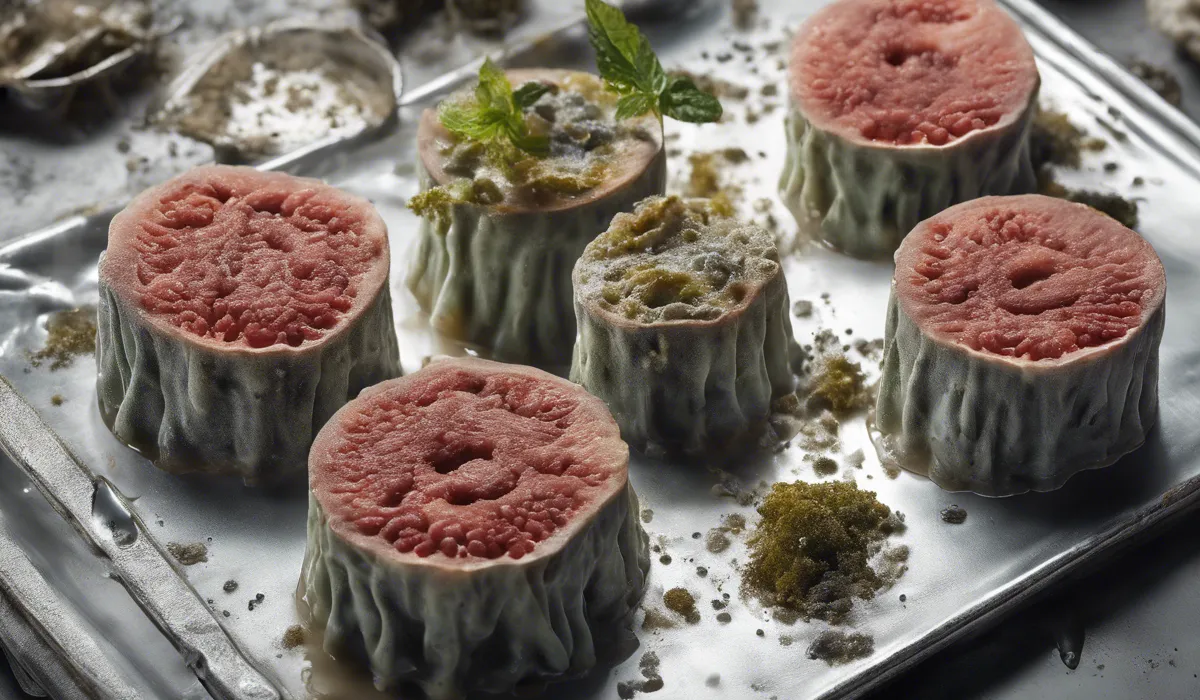Food mold can be dangerous as it may produce harmful toxins, like mycotoxins. Certain molds cause allergic reactions and respiratory issues. Not all molds are harmful, but it’s best to avoid ingesting moldy food.
Understanding Food Mold

What is Mold?
Mold is a type of fungus that can grow on many different surfaces, including food. It comes in various colors like green, white, or black.
Some common types of mold that you might find on your food include Penicillium, Aspergillus, and Rhizopus. These are not plants or animals but live organisms that can spread quickly.
Conditions for Mold Growth
Mold loves moist, warm places. It starts as spores that are too small to see without a microscope.
These spores float through the air and when they land on food that is wet and not too cold or too hot, they grow into mold.
Different types of mold prefer different kinds of food and environments, but most of them grow well when it is between 60 and 80 degrees Fahrenheit.
Visible and Invisible Mold
Sometimes you can see mold on food, like the fuzzy green spots on bread or the white threads on fruits.
But mold can also be invisible, hiding under the surface. Just because you can’t see it doesn’t mean it’s not there. If there’s a little bit of mold on the surface, there might be a lot more below.
Mold as a Decomposer
Mold is a decomposer, which means it breaks down dead materials. In nature, mold helps turn fallen leaves and dead trees back into soil.
When mold grows on food, it is doing the same thing, breaking the food down. While this is good for the environment, it is not good for food we want to eat.
Health Risks Associated with Consuming Moldy Food

Allergic Reactions and Food Poisoning
When you eat moldy food, you might feel sick right away. This can be because of an allergic reaction or because the mold has made toxins that act like poison in your body.
Symptoms can include sneezing, coughing, or stomach pain. Some people might even throw up or have diarrhea.
Mycotoxins and Long-Term Health Risks
Some molds make mycotoxins, which are chemicals that can be very harmful if you eat them a lot over a long time.
They can make you more likely to get sick from other things and can cause serious health problems like cancer or kidney damage.
Who Is at Risk?
Anyone can get sick from eating moldy food, but some people are more at risk. This includes older people, babies and young children, pregnant women, and people who are already sick or have a weak immune system.
These people should be extra careful to avoid moldy food.
Watch Out for Aflatoxin
Aflatoxin is a type of mycotoxin that can be very dangerous. It is made by certain kinds of mold that grow on peanuts, corn, and other grains.
Aflatoxin can cause liver damage and is known to lead to cancer if you eat too much of it over time.
Safe Practices to Handle Moldy Food

When to Throw Away Moldy Food?
For most foods, if you see mold, you should throw it away. This includes soft fruits and vegetables, bread, jams, and yogurt.
Mold can spread through these foods quickly and can be hiding below the surface.
When Can You Cut Away the Mold?
With some hard foods like hard cheese and firm vegetables, you can cut at least one inch around and below the mold spot.
After cutting away the mold, the rest of the food might be okay to eat. But be sure to keep the knife away from the mold to avoid spreading it.
Storing Food to Prevent Mold
To keep mold from growing, store food in a clean, dry, and cold place. The fridge is good for this.
Also, keep food in tight containers to keep the moisture out. When you keep food like this, it will stay fresh longer and be less likely to get moldy.
Keeping Your Kitchen Mold-Free
It’s important to clean your kitchen often to keep mold away. Wipe down surfaces, especially if something spills.
Make sure to not leave food out for too long, and don’t let trash pile up. A clean kitchen helps keep your food safe from mold.
FAQs About Food Mold Danger
Is it safe to eat around the mold on food if you remove the moldy part?
It is not safe to eat around the mold on food because mold can have invisible threads that penetrate deep into the food, and harmful toxins may still be present even after removing the moldy part.
Can food mold cause immediate health problems?
Food mold can cause immediate health problems such as allergic reactions and respiratory issues in sensitive individuals.
Are there any molds that are safe to eat?
Some molds are used in the production of certain cheeses and are safe to eat, but in general, it’s best to avoid consuming moldy food.
What should I do if I accidentally eat moldy food?
If you accidentally eat moldy food, most people will not experience any immediate issues, but if you feel unwell or have concerns, you should consult a healthcare professional.
How can I prevent mold from growing on my food?
To prevent mold from growing on food, store items properly, keep your storage areas clean, dry, and cool, and consume perishables within a safe time frame.
Final Thoughts
Mold on food can produce detrimental mycotoxins and pose health risks, including allergic reactions and respiratory problems.
While not all molds are harmful, consumption of moldy food is generally advised against to prevent potential exposure to these toxins and health concerns.
